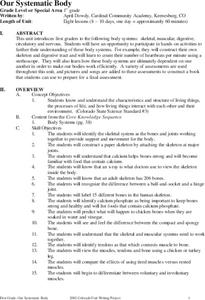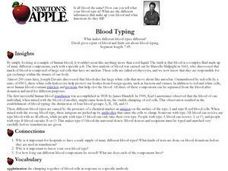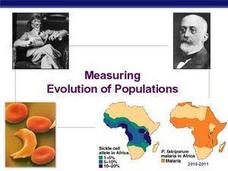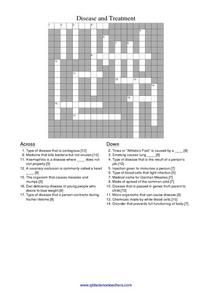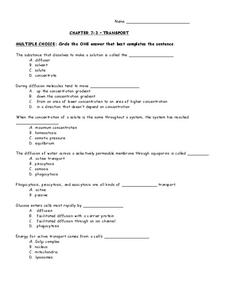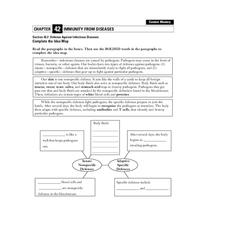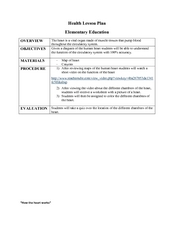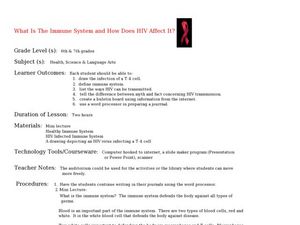Curated OER
The Cardiac 100
Students make a full scale diagram. In this heart and blood flow lesson, students pretend they must design the cardiac 100 racecourse and they must teach the new blood cells how to get around the heart. Students create a mini drawing and...
Curated OER
Inside the Cell
In this science worksheet, students study the structure and function of the cell by reading the information, studying the pictures and diagrams and finally completing a challenging crossword puzzle. There are 84 pages available.
Curated OER
Infection Wars
Students observe blood cells under a microscope and make drawings of their observations. They write and act out a short play starring blood cells, antibodies and bacteria to demonstrate fighting infection.
Curated OER
Heating and Cooling a Really Large Lizard
Remind your middle school scientists how fox ear size varies depending on the climate they live in; large ears allow heat loss while small ears keep heat in. Discuss how a cold-blooded animal might try to regulate body temperature. Then...
Curated OER
Our Systematic Body
Students explore several parts of the body system in the eight lessons of this unit. Through several hands-on activities, the skeletal, muscular, digestive, circulatory and nervous systems are observed.
Curated OER
Making Blood
Fifth graders review what they have already gathered about human blood. After reviewing the components of blood, they work together to make their own. Using the internet, they complete a blood web hunt and share their discoveries with...
Curated OER
Fighting Infection
Students study immune responses and the structures that are related to immune cells functions. In this fighting infection activity students construct antibody complexes and model the interaction of the immune system when it is...
Curated OER
Pre-Hardy-Weinberg
Students examine the inheritance of ABO blood groups. In this investigative instructional activity students perform a lab and show how natural selection can alter the gene frequencies in a population.
Curated OER
What's Your Type
Students record their blood types on a class graph and calculate the potential number of blood donors for each group.
Curated OER
Circulatory System
The ciculatory system is introduced here by means of clear, labelled diagrams and charts with details. After learning the basics of the heart strucure, a sequence of slides help show the flow the blood as the heart muscle contracts. A...
Curated OER
The Magic School Bus Inside Ralphie
Learners learn along with Ms. Frizzle's class. In this Magic School Bus lesson plan, students discover that skin protects our bodies the way apple skin protects an apple.
Curated OER
Measuring Evolution of Populations
The Hardy-Weinberg principle is the focus of this concise slideshow. Some vocabulary definitions are given on the first 2 slides, and the rest are given over to examples of the Hardy-Weinberg theorem. Calculations of the H-W...
Curated OER
Disease And Treatment
In this Disease and treatment worksheet, students solve 17 clues in a crossword puzzle about types of diseases, types of micro-organisms and immune system cells.
Curated OER
Transport
A multiple-choice quiz about the transport of substances between cells, this would work well as a pretest and/or post-test. It refers to chapter seven of an unnamed textbook, but it is a Word document, so it can easily be edited.
Curated OER
Chancing it
Seventh graders examine different transplant types and estimate the possible outcomes. In this biology lesson students discuss donors and transplants then divide into groups and complete a worksheet.
Curated OER
Extraction of DNA from White Onion
Students conduct lab test with minced onion to determine where chromosonal DNA is located within the cell, and whether or not it can be extracted.
Curated OER
PICTURE PERFECT PYRAMID
Middle schoolers create a model of the USDA's Food Pyramid Guide, using shoe boxes. They bring an assortment of shoe boxes from home. Students are given a copy of the "Food Guide Pyramid." They wrap boxes for the bread group in white,...
Curated OER
Defense Against Infectious Diseases
In this infectious diseases worksheet, students read about the two types of defenses the body has against pathogens: innate (nonspecific) and adaptive (specific). Students then complete a graphic organizer by filling in 11 blanks.
Curated OER
Circulatory System,
Fourth graders study the components and physiology of the human circulatory system.
Curated OER
Circulatory System Design
Students identify the different parts of the circulatory system and their function. They work together to create their own model of the system and use it to determine the rate of blood flow. They answer questions related to their model.
Curated OER
What is the Immune System and How Does HIV Affect It?
Student discuss the effect of HIV on the immune system. In this human body lesson, students research the immune system and how the HIV virus weakens it. They create a bulletin board showing how HIV is transmitted.
IBM
The Human Body
Every moment, the systems in your body are working together to keep you breathing, standing, and thinking. Elementary schoolers explore the human body and its systems with an impressive, 15-page lesson plan that should leave your...
Curated OER
Health Physics: The Effects of Radiation on Living Things
A mix of scientific details and background information about the well-known sites of radiation attacks or accidents. This topic may open up details that you may consider as sensitive, and could be upsetting to some pupils. This is a...
Curated OER
Animal Diseases
Many of the toxins and parasites that cause illness are specified and discussed in this slideshow. Poisoning and other mechanisms by which an animal can fall ill are detailed and the information about frequency, prevention and...
Other popular searches
- Red & White Blood Cells
- White Blood Cells Video
- Leukocytes/white Blood Cells
- Red and White Blood Cells






